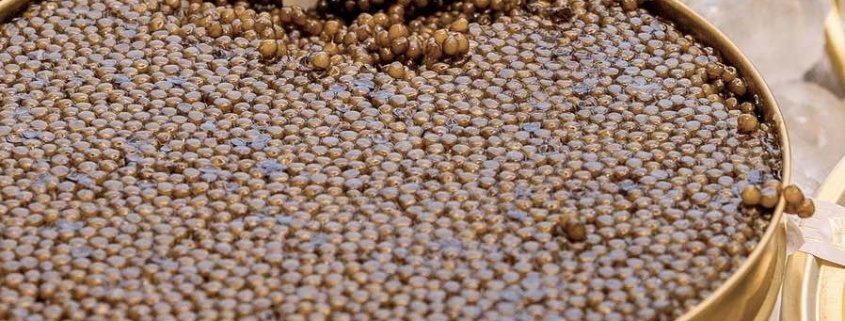
“I’d do anything for caviar and probably did.” One of my favorite quotes of all time, this famed proclamation came from Henry Kissinger. It doesn’t answer the question, “Is caviar aphrodisiac?” But it does make me giggle when I think of caviar in its most notorious context.
Kissinger was not alone in his passion for these pearl-like, salty-sweet eggs. In fact, they’re considered to be the most extravagant aphrodisiac in the world, (with the possible exception of black truffles). Casanova liked to pop a spoonful or two of the succulent treat. Dostoevsky, Madame du Barry and even Rasputin considered this food of indulgence their “drug” of choice.
Why fish roe is a symbol of fertility
Like all eggs, caviar is associated with new life. In fact, eggs were considered the ultimate symbol of fertility for many ancient nations. When the eggs of fish were first discovered, these tiny pearls of the sea were thought to give the eater a long life.
And the sense of luxury that comes with dipping your spoon into a bowl of these delicate pearls makes the experience far sexier than the act of consuming more pedestrian chicken eggs. (How could this not be linked with desire?) The tactile sensation of the black pearls bursting against the tongue adds to the sensualist’s delight with this gastronomic indulgence.
Is caviar healthy?
Though it may be pricey, I think you can make the argument that this diamond of the sea is not an indulgence but a necessity. Regarded from a nutritional standpoint, fish eggs, like poultry eggs, offers an easily digested source of lean protein. And protein provides the aphrodisiac of sustained energy. But fish roe is superior to poultry eggs because of another benefit. It contains the amino acid l-arginine, a vascular dilator that helps increase blood flow.
You may have heard of l-arginine in the context of treating male sexual dysfunction. So it’s fair to say that caviar, as a source of this nutrient, can support men’s sexual health.
Caviar’s surprising health benefit
Furthermore, thanks to a study completed in 1999 by Dr. Andrew Stoll of MacLean Hospital in Massachusetts, we now know that caviar, a source of Omega 3 fatty acids, may be beneficial in treating depression and bipolar disorder. Omega nutrients can be administered effectively in capsule form, but that wouldn’t be nearly as much fun as diving into a tin of caviar for your daily dose. Neither would popping zinc supplements when you can get this nutrient, essential for maintaining good blood flow, from spooning sturgeon. Is there any wonder why it’s one of the world’s most popular aphrodisiacs?
The proper way to serve caviar
The serving of this luxury of the sea is nearly always a ceremonious event. The Russian tradition of preparing caviar and blini is nearly tantric in its ordered movements. Connoisseurs recommend eating caviar from a wooden or shell spoon, believing that metal will taint the delicate eggs’ flavor.
It is also recommended that caviar be served at room temperature, not directly from the fridge. I’ve even had connoisseurs tell me that eating the fish eggs from a lover’s skin provides the best possible temperature at which to enjoy the seductive seafood.
How do you store caviar?
In order to optimize the experience, proper storage is a necessity. According to importer Great Atlantic Trading, caviar should be stored at the coldest part of your refrigerator. (The optimal storage temperature is about 28 degrees). At this temperature, an unopened tin will last as long as 5-6 weeks (although I can’t help wondering who could ever hold on to an unopened tin for 5 weeks!) Opened, the tin will last one or two weeks. Freezing caviar risks destroying the individual pearls’ sensual “pop.”
Storing other fish roe
The rules for storage apply to the roe of any fish generically referred to as caviar. (Common varieties include salmon, lumpfish and the tiny flying fish roe popular in sushi restaurants). However, these products are not true caviar. If you examine the label, you will notice that producers are required to list the type of fish on the label, as in “salmon caviar.” The only product that can be labeled simply as “caviar” is the roe of sturgeon.
What is the best caviar?
The most-prized fish roe in the world comes from three specific species of sturgeon indigenous to the Caspian Sea: Sevruga, Osetra and Beluga. Sadly, in 2006 the United Nations was forced to put a temporary ban on Caspian Sea caviar when it was discovered how seriously the region had been over-fished. Luckily, the situation was put under control before Beluga, the most prized of the three, became completely extinct. (The ban was partially lifted in 2007, but concerns remain even today.)
Can caviar be farmed?
During the time of the Caspian Sea ban, American-farmed caviar came into its own. The farmed fish egg industry is environmentally responsible, yet it is a high-grade alternative to Caspian fish roe. The aquafarm of Tsar Nicoulai in Northern California is considered a world leader in sustainable sturgeon farming. (So now you can feel the altruism when dropping your entire holiday bonus on fish eggs.)
In the past decade marked efforts have also begun in Italy and France to farm sturgeon for their prized eggs, with a hope that premium caviar will one day again be widely available. But then again, there is something sexy about the unattainable. After all, isn’t playing hard-to-get the ultimate aphrodisiac?
Sources:
Caviar: a global history
Can Caviar Cure Depression?
Discover more of the world’s greatest aphrodisiac foods



Leave a Reply
Want to join the discussion?Feel free to contribute!